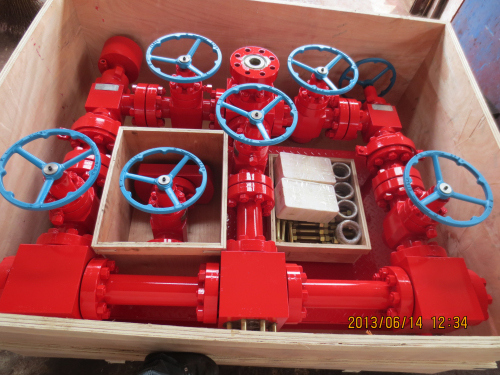- Model NO.: api 16C
- Power Source: Hydraulic
- Applicable Medium: Mud, Water, Natural Gas, Crude Oil
- Material: Alloy
- Transport Package: Wooden Case Box
- Origin: China
- Certification: ISO 9001:2000
- Operation Pressure: Atmospheric Pressure
- Structure: Horizontal
- Trademark: JELIN
- Specification: API 16C
- HS Code: 8431431000
Choke manifold is a necessary device for controlling well kick and implementing oil-gas well pressure control. When blowout preventer is closed, choke valve can be turned on and off to control certain casing pressures to keep bottom hole pressure a little higher than formation pressure all the time, lest formation fluid should further flow into well. Besides, when well is shut off, choke manifold can be relieved for the realization of soft shut-in. When the pressure rises to a certain level, it can be used to open the well for gushing so as to protect the well.
Choke manifold is composed of choke valve, gate valve, pipeline, pipe fittings and pressure gage, etc.
When well pressure rises, the choke valve (it falls into three kinds: Manually adjustable, hydraulic and positive) on choke manifold can be turned on and off to release the fluid to control casing pressure. Gate valve can be used for direct blowout. When casing pressure is pretty high,
The pressure class of our company's chokes manifold falls into five class: 14MPa, 21MPa, 35MPa, 70MPa and 105MPa. Also, we can design according to customer demand.
| Name | Choke manifold | Kill manifold | |||||
| Model | JG/S2-35 | JG/SY-35 | JG/SY2-70 | JG/S2Y2-105 | YG-35 | Y-70 | YG-105 |
| Main diameter and sideward diameter | 31/8× 21/16(80× 52)  41/16× 29/16(103× 65)  41/16× 31/16(103× 78) | ||||||
|  psi(MPa) Working pressure psi (MPa) |
3000(21) 5000(35) |
3000(21) 10000(70) |
5000(35) | 10000(70) | 15000(105) | ||
| (° F) Working temperature  º C (° F) |
LU  -46º C ~ +121º C    (-50° F ~ 250° F) | ||||||
| Working mediums | Drilling fluid,  mud and petroleum (with sulfuretted hydrogen) | ||||||
| Control type | Two-winged manual choke valve | Two-winged  hydraulic manual choke valve | Three-winged hydraulic manual choke valve | Four-winged double-hydraulic manual choke valve | Two-winged main relief valve | ||

Â
The shock absorbers in your car or truck help to ensure a good grip on the roads and drastically reduce the impact of road shocks.
The shock absorbers are made up of a set of parts, including the shock absorber cups or strut mounts.
A shock absorber or damper is a mechanical or hydraulic device designed to absorb and damp shock impulses. It does this by converting the kinetic energy of the shock into another form of energy (typically heat) which is then dissipated. Most shock absorbers are a form of dashpot (a damper which resists motion via viscous friction).Pneumatic and hydraulic shock absorbers are used in conjunction with cushions and springs. An automobile shock absorber contains spring-loaded check valves and orifices to control the flow of oil through an internal piston (see below).
One design consideration, when designing or choosing a shock absorber, is where that energy will go. In most shock absorbers, energy is converted to heat inside the viscous fluid. In hydraulic cylinders, the hydraulic fluid heats up, while in air cylinders, the hot air is usually exhausted to the atmosphere. In other types of shock absorbers, such as electromagnetic types, the dissipated energy can be stored and used later. In general terms, shock absorbers help cushion vehicles on uneven roads.
In a vehicle, shock absorbers reduce the effect of traveling over rough ground, leading to improved ride quality and vehicle handling. While shock absorbers serve the purpose of limiting excessive suspension movement, their intended sole purpose is to damp spring oscillations. Shock absorbers use valving of oil and gasses to absorb excess energy from the springs. Spring rates are chosen by the manufacturer based on the weight of the vehicle, loaded and unloaded. Some people use shocks to modify spring rates but this is not the correct use. Along with hysteresis in the tire itself, they damp the energy stored in the motion of the unsprung weight up and down. Effective wheel bounce damping may require tuning shocks to an optimal resistance.
Shock Absorber,Strut Shock Absorber,Truck Shock Absorbers,Suspension Shock Absorber
Wenzhou Huaming Automotive Components Co.,ltd. , https://www.dqz-duchiez.com